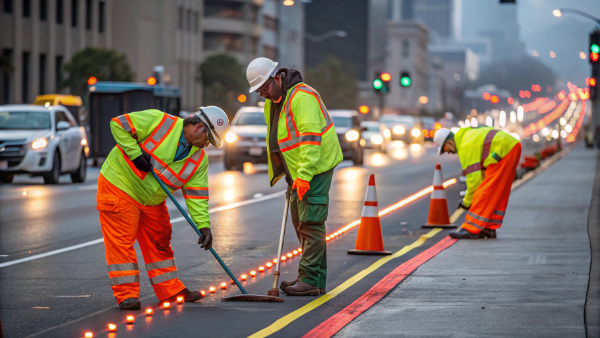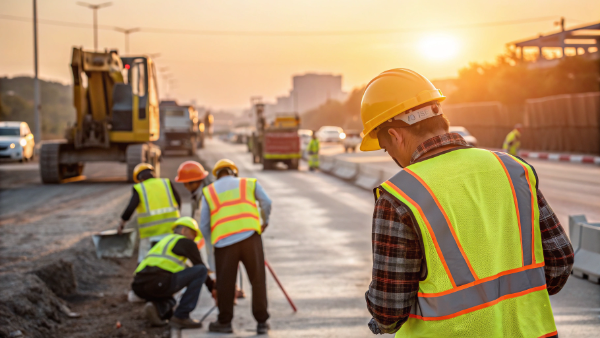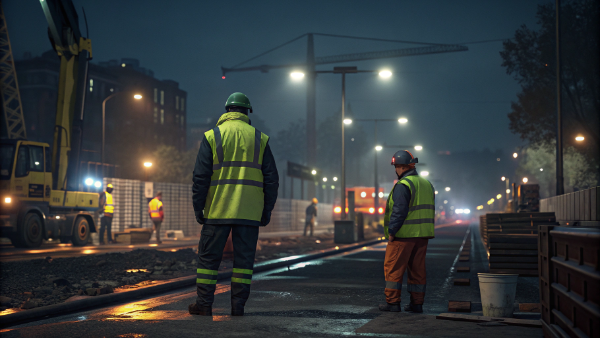Struggling with bulky, hot safety vests in the summer heat? This gear can be uncomfortable. A high-quality reflective T-shirt offers a cooler, safer, and more comfortable solution for your team.
A knitted reflective T-shirt combines a breathable, soft fabric base with high-grade retroreflective tape. This design provides ANSI/ISEA-compliant visibility for worker safety, while delivering superior comfort compared to a standard vest, especially in warm climates. It's the modern choice for safety and performance.
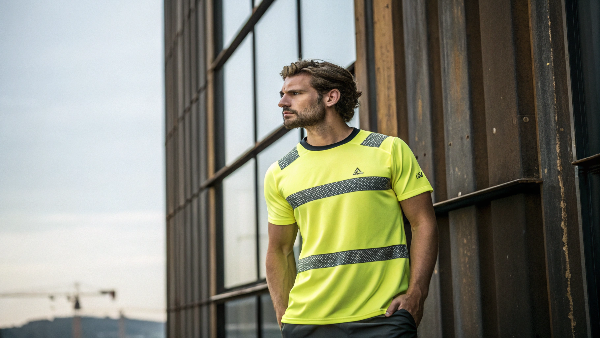
These T-shirts are more than just comfortable safety gear. They are built on specific science and standards that keep workers safe. As someone who has been supplying PPE for over 25 years, I've seen how the right gear can make a huge difference. Let’s dive into the details you need to know, from how the technology works to how to choose the right class for your job. There is a lot to learn, and understanding it will help you make better choices for your team's safety.
How do reflective shirts work?
Ever wonder how that simple tape on a shirt shines so brightly? It isn't magic, but it is clever science. I’ll explain the simple principle that makes it all happen.
Reflective shirts use retroreflective materials1, such as microscopic glass beads or microprisms. These materials are engineered to bounce light directly back to its original source with very little scattering. This makes the wearer appear exceptionally bright and visible to anyone with a light source, like a driver.
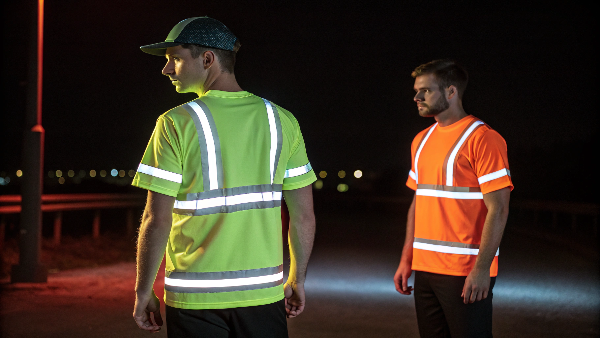
The core technology is called retroreflection. Think of it this way: a mirror reflects light, but it bounces off at an angle. Retroreflection sends light straight back. This is why a person wearing a reflective T-shirt seems to glow when a car's headlights hit them. The light from the car goes to the shirt and bounces directly back to the driver's eyes. This makes the person stand out sharply against a dark background.
For my business, ensuring the quality of this retroreflective material is my top priority. I work with my long-term partner, Vissafety, to source materials that meet and exceed ANSI/ISEA 107 standards2. We look at two main types.
Key Retroreflective Materials
| Material Type | How It Works | Key Advantage |
|---|---|---|
| Glass Beads | Tiny glass spheres are embedded in an adhesive layer. Light enters a bead, reflects off the back surface, and returns to the source. | Very flexible and cost-effective. Great for T-shirts where comfort and movement are important. |
| Microprismatic Tape | Made of tiny, precisely angled prisms. Each prism acts like a corner reflector, bouncing light back with high efficiency. | Extremely bright, especially in wet conditions. More durable and ideal for high-risk environments. |
Choosing the right one depends on the job. For a basic T-shirt, high-quality glass beads work well. For jackets used in heavy rain, microprismatic tape3 is a better choice.
Can reflective clothes go in the dryer?
You washed and dried your safety vest4, but now the tape is peeling. That high heat just ruined an expensive piece of gear. Let me show you the right way to care for it.
No, you should avoid putting reflective clothing5 in a machine dryer. The high heat can melt the adhesive that bonds the reflective tape to the fabric. It can also damage the tiny glass beads or prisms, which significantly reduces the garment's reflectivity and shortens its lifespan.

The reflective tape on your T-shirt is a sensitive component. It is attached with special adhesives and contains materials that are vulnerable to high temperatures. A standard dryer can reach heats that soften this adhesive, causing the tape to lift, crack, or peel off completely. Once the tape is damaged, the garment no longer meets safety standards and must be replaced. This is a costly mistake I always warn my clients about.
Proper care is simple and extends the life of your gear, ensuring it protects your workers as intended. Vissafety always includes clear care instruction labels on their garments, which is a small but critical detail for maintaining compliance. Here is a simple guide I share with all my customers.
Reflective Clothing Care Guide
| Action | Recommendation | Why It's Important |
|---|---|---|
| Washing | Machine wash on a gentle cycle with cold water. Use a mild detergent. Turn the garment inside out before washing. | Protects the reflective tape from abrasion against other clothes and the machine drum. Cold water prevents heat damage. |
| Drying | Always hang to dry (air-dry). Do not use a machine dryer. Keep it out of direct, intense sunlight for long periods. | This is the most critical step. It preserves the adhesive and the reflective material, ensuring the garment remains effective. |
| Storing | Store in a cool, dry place away from direct sunlight. Do not store it crumpled or folded on the tape lines for long. | Protects the materials from UV degradation and prevents permanent creases in the reflective tape. |
What is the best reflective material for clothing?
Not all reflective materials are created equal. Choosing the wrong type can compromise safety and lead to non-compliance. I'll help you understand the best options for different needs.
The "best" material depends on the job. For maximum brightness and durability, especially in wet weather, microprismatic tape is superior. For general use where flexibility and comfort are key, high-quality glass bead tape is an excellent and common choice. Both are effective when they meet ANSI standards.
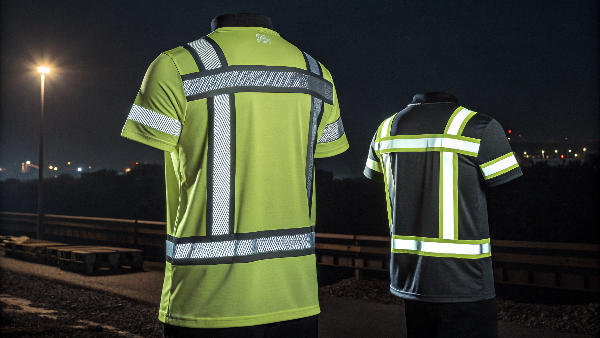
For the last 25 years, I’ve seen material technology evolve. What we have today is far superior to older products. The choice comes down to balancing performance, durability, and cost for a specific application. In my work with Vissafety, we often develop products for clients with very specific needs, which means we have to be experts on these materials. For example, a client in the rainy Pacific Northwest needed a jacket that stayed bright when wet, so we used a microprismatic tape.
Here’s a breakdown of the two main players in the market to help you decide.
Reflective Material Comparison
| Feature | Glass Bead Tape | Microprismatic Tape |
|---|---|---|
| Reflectivity | Good to very good | Excellent, especially when wet |
| Durability | Good; can be affected by abrasion | Excellent; very resistant to wear and tear |
| Flexibility | Very flexible, comfortable on knit fabrics | Can be stiffer, but new versions are improving |
| Cost | More economical | Higher initial cost |
| Best For | T-shirts, general workwear, situations where comfort is a top priority. | High-risk jobs (highway work), rainwear, garments needing maximum brightness and long life. |
Ultimately, the best material is one that is certified to ANSI/ISEA 107. This ensures it has been tested to perform under real-world conditions.
Who wears reflective clothing?
You might think reflective clothing is only for construction workers. The truth is, many more professionals rely on it every day for their safety. Let's look at who really needs this protection.
Anyone who works on or near roads with moving traffic or around heavy equipment wears reflective clothing. This includes road crews, utility workers, emergency responders, airport ground personnel, and warehouse staff. It is also used by cyclists and runners for personal safety.
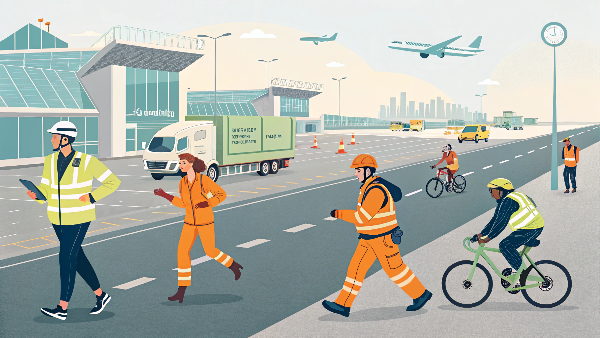
The core principle is simple: if you need to be seen to stay safe, you need high-visibility clothing. The human eye is drawn to bright, fluorescent colors during the day and sharp, reflected light at night. This gives drivers and equipment operators precious extra seconds to see a person, react, and avoid a collision.
Over my years in the PPE business, my client base has expanded far beyond just construction. I supply hi-vis gear to a huge range of industries here in North America. Each has unique risks, but the fundamental need for conspicuity is the same. It's about separating a person from their background environment.
Key Industries Using Reflective Clothing
| Industry | Key Risks | Common Garment |
|---|---|---|
| Construction & Road Work | High-speed traffic, heavy machinery | Class 2 or Class 3 vests, jackets, and T-shirts |
| Logistics & Warehousing | Forklifts, moving trucks in yards | Class 2 T-shirts or vests |
| Emergency Services | Traffic at accident scenes, low-light rescues | Class 3 jackets, public safety vests (ANSI 207) |
| Utilities & Telecom | Working near roadways, night repairs | Class 2 or Class 3 rainwear and jackets |
| Recreation | Vehicle traffic during runs or rides | Lightweight vests or shirts |
A few years ago, a large logistics client implemented a mandatory reflective T-shirt policy for their yard workers. They reported a significant drop in near-miss incidents. That’s the real-world impact of the right gear.
What is reflective clothing called?
You have probably heard different names for this type of gear. Is it "hi-vis", "high-viz", or something else entirely? I’ll clarify the correct industry terms so you know exactly what to ask for.
The official industry term is "high-visibility clothing," often shortened to "hi-vis" or "hi-viz." While people might call it "safety gear" or "reflective wear," the term "high-visibility" specifically refers to clothing that meets official safety standards like ANSI/ISEA 107.

Using the right terminology is important, especially when you are responsible for worker safety and compliance. When I place an order with Vissafety for a client, we use precise language. This ensures there is no confusion about the product's features, color, or, most importantly, its safety class. The term "high-visibility" covers the two key features of the garment: the fluorescent background material for daytime visibility and the retroreflective tape for nighttime visibility.
While different terms are used casually, in a professional context, being specific matters. It shows you understand the safety standards and are serious about providing compliant, effective protection for your team.
Common Terminology Explained
| Term | Status | Context of Use |
|---|---|---|
| High-Visibility Clothing | Official Standard | The formal term used in regulations like ANSI/ISEA 107 and OSHA guidelines. Use this in official documents. |
| Hi-Vis or Hi-Viz | Common Industry Slang | Widely used and understood by manufacturers, distributors, and end-users. Perfect for daily conversation. |
| Reflective Clothing | Descriptive | A general term that focuses only on the retroreflective aspect. It may not always refer to a compliant garment. |
| Safety Vest/T-Shirt | Descriptive | Describes the type of product but doesn't guarantee it meets any specific high-visibility standard. |
When ordering, I always specify "ANSI Class 2 Hi-Vis T-Shirt" instead of just "safety shirt." This precision is key to a reliable supply chain.
What makes reflective clothing glow?
It often looks like reflective clothing is creating its own light. But there are no batteries or power sources. The secret is not in making light, but in how it uses it.
Reflective clothing does not "glow" on its own; it reflects light. It uses a special property called retroreflection. This technology bounces light from a source, like a car's headlights, directly back to the source, making the material appear intensely bright to the person near the light source.
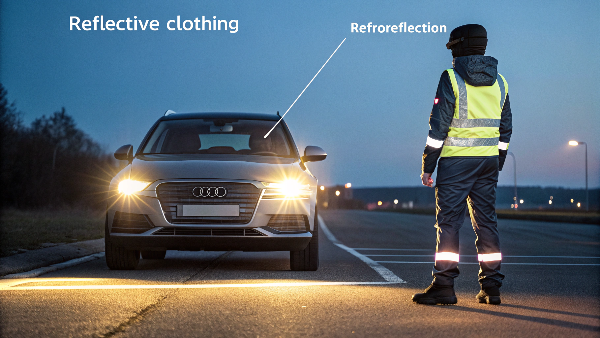
This "glowing" effect is an illusion, but it's a life-saving one. The materials are designed to be incredibly efficient at returning light. This is very different from how your other clothes work. A normal shirt scatters light in all directions, so very little of it returns to the driver's eyes. A reflective shirt acts like a focused beam, sending almost all the light straight back.
It is also important to understand the difference between the various light-related properties you see in safety gear. They all work together to keep a person visible in different conditions.
How Visibility Technologies Differ
| Technology | How It Works | Best Used For | Power Source |
|---|---|---|---|
| Retroreflection | Bounces light directly back to its source using glass beads or prisms. | Nighttime and low-light conditions. | External light (e.g., headlights, flashlights). |
| Fluorescence | Absorbs non-visible UV light and re-emits it as bright, visible light. | Daytime, dawn, and dusk. | Ambient sunlight (UV rays). |
| Phosphorescence | Absorbs and stores energy from a light source, then releases it slowly as a faint glow. | Total darkness after being "charged." | "Charges" under an external light source. |
A high-quality reflective T-shirt from Vissafety uses both a fluorescent background fabric for daytime safety and retroreflective tape for nighttime protection.
What is the best reflective color to be seen?
You see safety gear in fluorescent yellow, orange, and even red. Does the color actually make a difference for safety? Yes, it absolutely does, and I’ll explain which is best for the job.
For daytime visibility, fluorescent yellow-green is scientifically the most visible color to the human eye across the widest range of environments. Fluorescent orange-red is a close second and provides better contrast against snowy or dense foliage backgrounds.

The goal of a high-visibility T-shirt is to create the highest possible contrast with the surrounding environment. Our eyes are most sensitive to the wavelength of light produced by fluorescent yellow-green. This makes it pop against most urban and rural backgrounds, from black asphalt to green trees. It is the most popular and versatile choice.
However, the work environment is the most important factor. For my clients whose crews work on highways in snowy states, I often recommend fluorescent orange-red. It stands out sharply against a white or gray backdrop. The ANSI/ISEA 107 standard approves three colors for high-visibility clothing because no single color is perfect for every situation.
Compliant Hi-Vis Colors and Their Uses
| Color | Best For | Why It Works |
|---|---|---|
| Fluorescent Yellow-Green | Most universal applications. Urban, suburban, and rural settings. | The brightest color to the human eye. Provides excellent contrast against most backgrounds, making it a great all-around choice. |
| Fluorescent Orange-Red | Winter conditions or areas with heavy foliage. | Offers superior contrast against snow, and also stands out well against green and brown natural landscapes where yellow might blend in. |
| Fluorescent Red | Specific applications, often in combination with other colors. | Provides good contrast, but is less common as a primary background color. It is often used in specific safety schemes. |
At Vissafety, we can produce garments in any of these compliant colors, allowing me to provide the perfect solution tailored to each of my client's unique work zones.
Why is it important to wear reflective clothing at night?
You might think that a driver can see you walking on the side of a road at night. But in dark clothes, you are practically invisible until it is far too late. Here's why hi-vis is a lifesaver.
It dramatically increases your conspicuity, which is the distance at which you can be seen. A driver can spot a person in reflective clothing from 500 feet or more away, giving them the critical time needed to slow down or steer clear. Without it, you might only be seen at 55 feet.
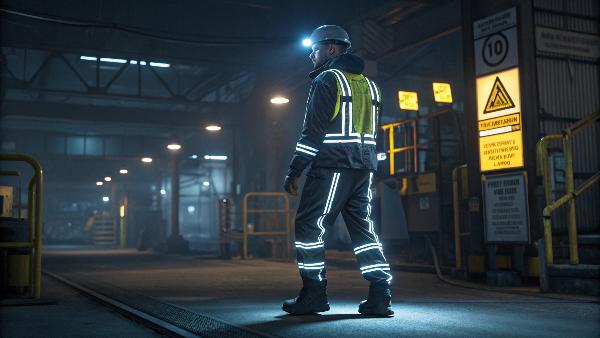
The difference is a matter of life and death. A typical car traveling at 60 mph needs over 300 feet to come to a complete stop. If a driver can't see you until they are 55 feet away, a collision is nearly unavoidable. Reflective clothing turns a dangerous situation into a manageable one by extending that detection distance.
This isn't just theory. It's the core reason my business exists. After a supplier once sent me a batch with inconsistent colors back in 2015, I learned a hard lesson about quality control. Now, I only work with manufacturers like Vissafety who have a triple-inspection process because I know that lives depend on the reliability of these products.
Visibility Distance and Driver Reaction
| Clothing Worn by Pedestrian | Typical Detection Distance | Time for a Driver at 50 mph to React |
|---|---|---|
| Dark Clothing | ~55 feet | Less than 1 second |
| White Clothing | ~180 feet | About 2.5 seconds |
| Reflective Clothing | ~500 feet or more | Almost 7 seconds |
Those extra seconds are everything. It is the difference between a close call and a tragedy. That is why wearing proper reflective gear at night is non-negotiable for any at-risk worker.
What are the different classes of reflective clothing?
You see different types of vests, shirts, and jackets on workers. They might look similar, but their safety ratings can vary widely. Let's decode the official ANSI/ISEA 107 classes.
The ANSI/ISEA 107 standard defines three classes of high-visibility clothing based on the amount of background and reflective material they have. Class 1 is for low-risk environments, Class 2 is for moderate risk, and Class 3 provides the highest level of visibility.

These classes are not arbitrary. They are designed to match the level of protection to the level of risk in a worker's environment. The risk is determined by factors like vehicle speed, traffic volume, and how much the worker's attention is diverted from traffic. As an employer or safety manager, choosing the right class is a critical responsibility.
For my clients in North America, I almost exclusively deal in Class 2 and Class 3 garments. The work environments in construction, logistics, and utilities simply demand that higher level of protection. I rely on Vissafety to manufacture products that precisely meet the material requirements for each class.
ANSI/ISEA 107 Class Comparison
| Feature | Class 1 | Class 2 | Class 3 |
|---|---|---|---|
| Use Case | Low-speed traffic (under 25 mph), far from road. e.g., Parking attendants. | Roadways with speeds 25-50 mph. e.g., Utility workers, survey crews. | High-speed traffic (over 50 mph), low visibility. e.g., Highway crews. |
| Min. Background Fabric | 217 sq. inches | 775 sq. inches | 1240 sq. inches |
| Min. Reflective Tape | 155 sq. inches | 201 sq. inches | 310 sq. inches |
| Common Garment | Simple vest | T-shirt, vest | Jacket, coverall, or Class 2 vest + Class E pants |
A reflective T-shirt can meet Class 2 or even Class 3 requirements if it has sleeves with reflective bands. It's a fantastic, comfortable option for many jobs.
What jobs use reflective clothing?
When you think of hi-vis gear6, you probably picture a construction site. But the need for this protection extends to a vast number of other professions. Let's explore the jobs that rely on it.
Many jobs require reflective clothing. The most common are road construction crews, utility workers, police and emergency responders, airport ground staff, railway workers, and warehouse personnel who work around forklifts and trucks. Essentially, any job performed near moving vehicles requires it.
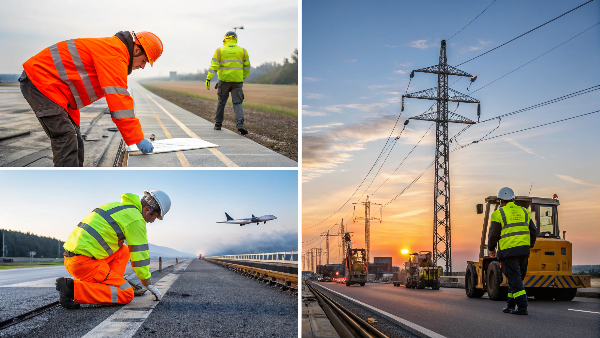
The unifying factor for all these jobs is a work environment where a person can be struck by a vehicle or mobile equipment. High-visibility clothing is the primary line of defense. It prevents incidents by making the worker stand out from their complex background, whether it's an urban street, a busy warehouse, or an airport tarmac.
My business in California serves a wide range of these professions. One day I might be supplying Class 3 bomber jackets to a highway paving crew, and the next I'll be delivering custom Class 2 reflective T-shirts with cooling fabric for a logistics company's distribution center. Vissafety's capability to produce this wide range of products reliably is why our 12-year partnership has been so successful.
Industries and Roles Requiring Hi-Vis Gear
| Industry | Specific Job Title | Primary Hazard |
|---|---|---|
| Transportation | Tow Truck Operator | Working alongside live, high-speed traffic. |
| Public Safety | Police Officer, Firefighter | Directing traffic, managing accident scenes at any hour. |
| Logistics | Yard Jockey, Forklift Operator | Navigating busy yards with trucks and containers. |
| Aviation | Baggage Handler, Marshaller | Working on the tarmac around moving aircraft and vehicles. |
| Waste Management | Sanitation Worker | Collecting refuse on public streets with passing cars. |
Each of these roles needs gear that is not only compliant but also functional and comfortable for a full day's work.
Conclusion
A reflective T-shirt is essential safety equipment. Understanding its technology, classes, and proper care ensures your team is visible, comfortable, and safe while on the job.
-
Explore this link to understand the science behind retroreflective materials and their applications in safety gear. ↩
-
Learn about ANSI/ISEA 107 standards to ensure safety and compliance in reflective clothing for various environments. ↩
-
Discover how microprismatic tape improves visibility and durability in safety gear, especially in challenging conditions. ↩
-
Proper care of safety vests is essential for compliance and safety. Discover detailed care instructions to extend the life of your gear. ↩
-
Understanding how to care for reflective clothing is crucial for maintaining safety and longevity. Explore this resource for expert tips. ↩
-
Discovering the types of jobs that require hi-vis gear can help workers understand their safety needs better. ↩

